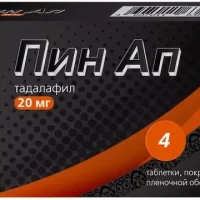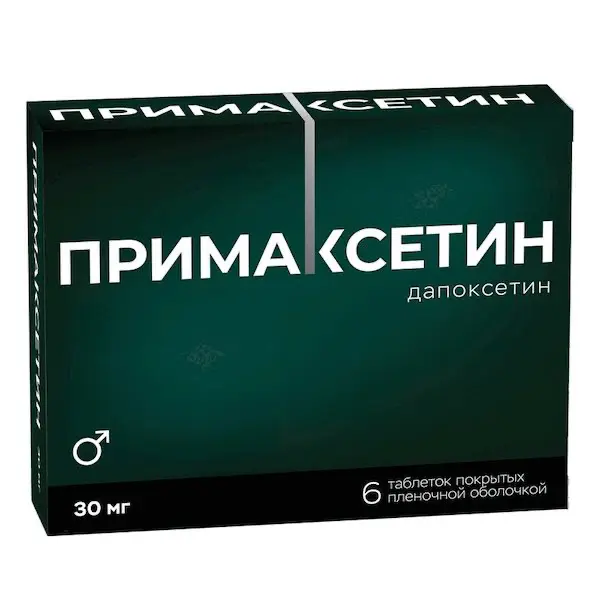Description
Pin AP Pharmacodynamics
Mechanism of action
Tadalafil is a reversible selective inhibitor specific to cyclic guanosine monophosphate (cGMP) phosphodiesterase type 5 (FDE-5). When sexual arousal causes local release of nitric oxide, inhibition of FDE-5 by tadalafil leads to an increase in the concentration of cGMP in the cavernous body of the penis. The consequence of this is relaxation of the smooth muscles and blood flow to the tissues of the penis, which causes an erection.
Erectile Dysfunction (ED)
Tadalafil has no effect in treating erectile dysfunction in the absence of sexual arousal.
Benign prostatic hyperplasia (BPH)
In the smooth muscles of the prostate, bladder and vessels that supply blood to them, inhibition of FDE-5 has a similar effect on cGMP concentration as in the cavernous body of the penis. As a result, vascular smooth muscle relaxes, which leads to increase of blood perfusion and, as a consequence, to reduction of severity of BPH symptoms. Inhibition of afferent activity of the bladder nerves and relaxation of the prostate and bladder smooth muscles may further enhance the vascular effects.
Pharmacodynamic effects
In vitro studies have shown that tadalafil is a selective inhibitor of FDE-5. FDE-5 is an enzyme found in cavernous body smooth muscle, vascular and visceral smooth muscle, skeletal muscle, platelets, kidney, lung, and cerebellum. Among all phosphodiesterases, tadalafil has the most pronounced effect on FDE-5. The effect of tadalafil on FDE-5 is more than 10,000 times greater than on FDE-1, FDE-2, FDE-3, and FDE-4 (enzymes found in the heart, brain, blood vessels, liver, and other organs). The selectivity of tadalafil against FDE-5 compared to FDE-3 is of particular importance because FDE-3 is an enzyme that regulates myocardial contractility. In addition, the effect of tadalafil on FDE-5 is approximately 700 times greater than on FDE-6 (the enzyme that is located in the retina and is responsible for phototransduction). Tadalafil is also more than 10,000 times more active against FDE-5 than against FDE-7 to FDE-10.
Clinical efficacy and safety
Tadalafil in healthy volunteers causes no significant changes in systolic and diastolic blood pressure in the supine position compared to placebo (mean maximum decrease is 1.6/0.8 mm Hg, respectively) and in the standing position (mean maximum decrease is 0.2/4.6 mm Hg, respectively). Tadalafil causes no significant change in heart rate.
In a study evaluating the effect of tadalafil on vision, color perception disorders (blue/green) using the Farnsworth-Mansell 100 color test were not found, which is explained by the lower affinity of tadalafil for FDE-6 compared to FDE-5. In all clinical trials, reports of color vision disturbances were rare (< 0.1%).
To evaluate the potential effect of tadalafil on spermatogenesis, three studies were conducted with men using the drug at a daily dose of 10 mg (one 6-month study) and 20 mg (one 6-month and one 9-month study). In two of these studies, there was a decrease in sperm count and concentration, the clinical significance of which is unlikely. These effects were not accompanied by changes in other parameters such as motility, morphology and follicle stimulating hormone (FSH) levels.
Erectile Dysfunction.
Three clinical studies were cited to evaluate the response period when tadalafil was used on demand. Patients took the drug at home. Tadalafil demonstrated statistically significant improvement in erectile function, the ability to have intercourse up to 36 hours after taking it, and the ability of patients to achieve and maintain an erection to have intercourse as early as 16 minutes after tadalafil administration compared to placebo.
In a 12-week study involving patients with erectile dysfunction developed as a result of spinal cord injury, tadalafil at a dose of 10 or 20 mg (nonstrict dosage, on demand) significantly improved erectile function compared with placebo.
To evaluate daily tadalafil doses of 2.5 mg, 5 mg, and 10 mg, 3 clinical studies were conducted demonstrating the effectiveness of tadalafil compared to placebo. Patients of different ages (ranging from 21 to 82 years) and ethnic groups with erectile dysfunction of varying severity (mild, moderate, severe) and etiology were included in the studies. One of these studies involved patients who developed erectile dysfunction against a background of diabetes mellitus.
- For oral administration.
- Pin Up administration for erectile dysfunction (ED)
- For patients with frequent sexual activity (twice a week or more): recommended frequency of use is daily, once a day, 5 mg, at the same time, regardless of meal time. The dose may be reduced to 2.5 mg once daily depending on individual sensitivity.
- The appropriateness of daily use of the drug should be periodically reviewed.
- For patients with infrequent sexual activity (less than twice a week): the recommended dose of Pin Up is 10 mg or 20 mg taken before the intended sexual activity, regardless of meals.
- In patients in whom Pin Up at a dose of 10 mg is not effective, a dose of 20 mg is used. The drug should be taken at least 30 minutes before sexual activity. The maximum frequency of administration is once a day.
- Tadalafil in doses of 10 mg and 20 mg is intended for use before intended sexual activity and is not recommended for continuous daily administration.
- Use of Pin Up for the indication of BPH or ED/DPH
- The recommended dose is 5 mg taken at approximately the same time each day regardless of meals. For adult men being treated for both benign prostatic hyperplasia and erectile dysfunction, the recommended dose is also 5 mg taken at about the same time each day.
- Special patient groups
- Elderly patients
- No dose adjustment is required in elderly patients.
- Patients with renal impairment
- No dose adjustment is required in patients with mild to moderate renal insufficiency. In patients with severe renal impairment, the maximum recommended dose when used on demand is a dose of 10 mg.
- Daily administration of tadalafil at doses of 2.5 mg and 5 mg for both erectile dysfunction and benign prostatic hyperplasia is not recommended in patients with severe renal impairment.
- Patients with hepatic insufficiency
- In the treatment of erectile dysfunction with tadalafil on demand, the recommended dose is 10 mg, which is taken before anticipated sexual activity regardless of meals. There are limited clinical data on the safety of tadalafil in patients with severe hepatic impairment; therefore, a careful individual evaluation of the benefit-risk ratio should be performed by the physician when prescribing this medication.



